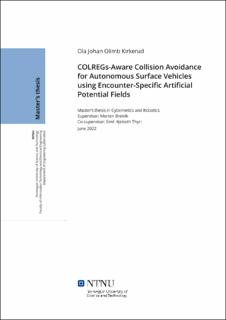| dc.contributor.advisor | Breivik, Morten | |
| dc.contributor.advisor | Thyri, Emil Hjelseth | |
| dc.contributor.author | Kirkerud, Ola Johan Olimb | |
| dc.date.accessioned | 2022-09-24T17:20:28Z | |
| dc.date.available | 2022-09-24T17:20:28Z | |
| dc.date.issued | 2022 | |
| dc.identifier | no.ntnu:inspera:102231297:48377524 | |
| dc.identifier.uri | https://hdl.handle.net/11250/3021094 | |
| dc.description.abstract | Det er mange ulike nivåer av autonomi, hvor full autonomi er det absolutt mest krevende nivået å produsere. Full autonomi krever et system som er uavhengig av menneskelig interaksjon. For å oppnå dette for et autonomt overflatefartøy (ASV), må systemet forstå omgivelsene, og lage en plan for hvordan den skal navigere for å nå målet sitt trygt. Systemet som er ansvarlig for å lage planene som sikrer trygg navigering, er ofte referert til som et kollisjonsunngåelses-system (COLAV-system).
I denne masteroppgaven foreslås en COLAV-metode for autonome passasjerferger. Metoden fungerer som et reaktivt lag i COLAV-systemet. Den bruker informasjon om miljøet og dets nominelle bane, for a bestemme posisjons- og hastighetsreferanser som sikrer kollisjonsfri og Konvensjon om Internasjonale Regler til Forebygging av Sammenstøt på Sjøen (COLREGs)-kompatibel navigering. Den nominelle banen er konstruert slik at den er kollisjonsfri for statiske hindringer. Den foreslåtte metoden overvåker kontinuerlig den estimerte tiden til det nærmeste tilnærmingspunktet (CPA) og avstanden ved CPA mellom seg selv og andre fartøyer, for å oppdage potensielle kollisjoner. En klassifiseringsmetode brukes deretter for å klassifisere møtegeometrien med respekt til COLREGs reglene. Metoden håndterer alle fartøy-til-fartøy (V2V) møter individuelt, ved å lage et unikt målskip domene for hvert hinderfartøy, der domenet er spesifikt til regelen som gjelder. Målskipets domene brukes deretter i et kunstig potensial felt (APF) for å beregne referanse signaler for fartøyets dynamiske posisjoneringssystem.
En simulator er blitt utviklet for å verifisere ytelsen til metoden. Fartøy og thruster model parametere ble bestemt fra parameterne som blir brukt i prototyp autonome passasjerfergen milliAmpere, sin simulator. Simulatoren er i stand til å simulere flere skip med ulik oppførsel.
Ytelsen til metoden demonstreres gjennom et stort sett med V2V-møter, hvor den håndterer hvert møte i samsvar med COLREGs reglene 13-15 og 17. Ytelsen til metoden demonstreres videre på mer komplekse møter med flere fartøyer, og gjennom introduksjonen av statiske hindringer i simuleringsmiljøet. Metoden sammenlignes til slutt med en APFbasert COLREGs uvitende COLAV-metode. | |
| dc.description.abstract | There are many different levels of autonomy, where full autonomy is the absolute most demanding level to produce. Full autonomy requires a system that is independent of human interaction. To achieve this for an autonomous surface vehicle (ASV), it must be able to understand its surroundings, and make a plan on how it will navigate to reach its goal safely. The system responsible for ensuring safe navigation, is often referred to as a collision avoidance (COLAV) system.
In this Master’s thesis, a COLAV method for ASVs is proposed. The method works as a reactive layer in the COLAV system. It uses information about the environment and its nominal trajectory, to determine position and velocity references that ensures collision free and Convention on the International Regulations for Preventing Collisions at Sea (COLREGs)-aware navigation. The nominal trajectory is constructed such that it is collision free to any static obstacles. The proposed method continuously monitors the estimated time to the closest point of approach (CPA) and the distance at the CPA between itself and other vessels to detect potential collisions. A classifier is then used to classify the encounter geometry with respect to the COLREGs rules. The method handles all vessel to-vessel (V2V) encounters independently, by creating a unique target ship domain for each target ship (TS), where the domain is specific to the rule that applies. The targetship domain is then used in an artificial potential field (APF) to calculate reference signals for the own ship (OS) dynamic positioning system.
A simulator is developed to verify the performance of the method. The vessel and thruster model parameters are determined from the parameters used in the prototype autonomous passenger ferry milliAmpere simulator. The simulator is capable of simulating multiple ships with different behaviors.
The performance of the method is demonstrated through a large set of V2V encounters, where it handles every encounter in accordance to the COLREGs rules 13-15 and 17. The performance of the method is further demonstrated on more complex multi-vessel encounters, and through the introduction of static obstacles in the simulation environment. The method is finally compared to an APF-based COLREGs-unaware COLAV method. | |
| dc.language | eng | |
| dc.publisher | NTNU | |
| dc.title | COLREGs-Aware Collision Avoidance for Autonomous Surface Vehicles using Encounter-Specific Artificial Potential Fields | |
| dc.type | Master thesis | |
